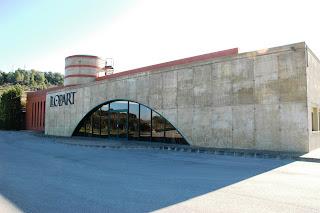As in most winegrowing zones, in Catalonia amateur wine tasting is an activity not only to be done individually or around a dinner table. There are many options, from the private wine tasting group or visit to small cellar, to the public wine exhibition with thousands of wine lovers.
My general position in this case is, yes, I like to attend these exhibitions. It is a good opportunity to:
- know interesting new wines
- taste different vintages of those I already know
- perhaps most important, chat with winegrowers.
The extent to which these three activities can be done depends on several variables: cost of the fee, popular appeal, and focus of the exhibition. In the very popular, unfocused events like the Mostra de Vins i Caves de Catalunya (Catalonia Wines Exhibition), held annually in Barcelona, the selection of wineries is not very rigorous, being official and, therefore, political. Also part of the large numbers of people who attend are not always interested in the quality of the offerings but rather in its alcoholic content. Catavins in Sabadell is less crowded and with a better selection.
However, often this bigger exhibitions include smaller events, often labelled as "for professionals", with greater interest (and price), such as a sideline of the Priorat and Montsant Fira del Vi (Wine Exhibition) in Falset: the Tast Presentació. In this case the top wines of ca. 60 wineries from Priorat and Montsant can be sampled just after leaving the barrels; in 2010 the wines from the 2008 vintage. All wineries complain that thewir wines should not be tasted yet, but all share the same problem and that evens things out.
The Fira del Vi in Falset is similar to other DO events, held in the DO capital, like ViJazz in Vilafranca del Penedès, Mostra del Vi de l'Empordà de Figueres , or Festa del Vi Gandesa (DO Terra Alta). They are often paired with other food exhibitions, like olive oil or cheese. Local restaurants are also on display.
Other opportunities arise in the local festivities. I have already written about the event in my own town, Sant Cugat de Vallès (Wine in the cloister) and in many winegrowing villages a wine tasting is one of the highlights. I was recently in Porrera (DO Priorat) for the TastaPorrera (TastePorrera) where over thirty wines of sixteen local producers could be tasted.
There are also specific wine festivities, especially around grape harvest. One of the nicest is Poboleda’s Festa de la Verema a l’antiga (Old Way Harvest). Apart from actually harvesting and treading grapes (a method no longer favoured by Poboleda’s wineries), more than 25 Priorat wineries offer their wines from the large halls of the beautiful houses that line the Carrer Major (High Street).
And then there are focused events, like the Fira dels Vins de Torrelles de Llobregat, with many small, organic producers.
Needless to say, these are not opportunities for what I may call scientific wine tasting, but wine must be seen as a source of happiness and merriment, and it is good to let go of the tasting notebook and just enjoy the infinite variety of the fermented grape juice and the sound, enthusiastic people that perform the miracle.
I would like to close this post with a wish of happiness and luck (and nice wines!) in 2011 for all of you that have taken the time to go through my clumsy prose and travel with me in this exciting adventure in the net. Thanks for your support and till next post.
http://www.festadelvi.cat/ca/index.htm
http://www.figueres.cat/eng/index.html
http://www.firadelvi.org/
http://mostradevinsicaves.cat/
http://www.vijazzpenedes.com/defaultvijazz.asp?idi=en
http://www.adictosalalujuria.com/2010/10/fira-de-vins-de-torrellas-conclusiones.html
http://catavinssabadell.com/













































